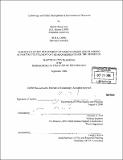| dc.contributor.advisor | Herman A. Karl. | en_US |
| dc.contributor.author | Yao, Basilia Wang | en_US |
| dc.contributor.other | Massachusetts Institute of Technology. Dept. of Urban Studies and Planning. | en_US |
| dc.date.accessioned | 2007-05-16T18:44:21Z | |
| dc.date.available | 2007-05-16T18:44:21Z | |
| dc.date.copyright | 2006 | en_US |
| dc.date.issued | 2006 | en_US |
| dc.identifier.uri | http://hdl.handle.net/1721.1/37474 | |
| dc.description | Thesis (M.C.P.)--Massachusetts Institute of Technology, Dept. of Urban Studies and Planning, 2006. | en_US |
| dc.description | Includes bibliographical references (p. 102-109). | en_US |
| dc.description.abstract | Since 1970, the National Environmental Policy Act (NEPA) has served as the main instrument for analyzing the environmental impacts of federal agency decisions and providing the public with opportunities to participate in the decision making process. For over 35 years, NEPA has defined the process by which agencies assess environmental impacts and disclose those assessments to the public. During this period however, NEPA has come under increasing scrutiny due to the considerable conflict surrounding environmental policies, eroding credibility of science-based policy information, and lack of meaningful public participation opportunities in practice. Experience has shown that collaborative decision making reduces conflict among participants, increases the credibility of science-based information underlying environmental decisions and improves the overall legitimacy of the participation process. The federal government has embraced web-based technology as a means of improving upon the traditional NEPA public participation process. Electronic participation has generated considerable interest among policymakers and scholars due to its potential to facilitate more efficient and more deliberative interaction between citizens and government. | en_US |
| dc.description.abstract | (cont.) This paper analyzes a pilot program by the Bureau of Land Management to integrate electronic participation into its decision making process. I evaluate four cases involved in the ePlanning pilot to understand the extent to which recent electronic participation efforts build upon established best practices in traditional, or offline participation. While there are some encouraging signs, most cases indicate that technology is applied mostly as a means of digitizing existing steps in the decision making process, rather than as a tool for enhancing the communicative and deliberative aspects of participation. The democratic potential of web-based technology lies not in the automation of existing practice, but in the support of established best practices. | en_US |
| dc.description.statementofresponsibility | by Basilia Want Yao. | en_US |
| dc.format.extent | 109 p. | en_US |
| dc.language.iso | eng | en_US |
| dc.publisher | Massachusetts Institute of Technology | en_US |
| dc.rights | M.I.T. theses are protected by copyright. They may be viewed from this source for any purpose, but reproduction or distribution in any format is prohibited without written permission. See provided URL for inquiries about permission. | en_US |
| dc.rights.uri | http://dspace.mit.edu/handle/1721.1/7582 | |
| dc.subject | Urban Studies and Planning. | en_US |
| dc.title | Technology and public participation in environmental decisions | en_US |
| dc.type | Thesis | en_US |
| dc.description.degree | M.C.P. | en_US |
| dc.contributor.department | Massachusetts Institute of Technology. Department of Urban Studies and Planning | |
| dc.identifier.oclc | 123985309 | en_US |
